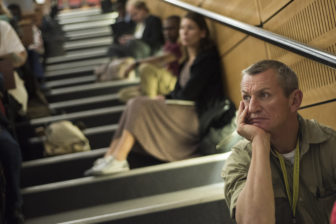
John Grobler, a Namibia journalist, collaborates with Chinese journalists in his reporting of rhino poaching. Photo: Madelene Cronjé
Ease up on the blood shots, ditch the undercover ploys and think crime story, not animal story.
These are top tips from Bryan Christy, author, investigative journalist and National Geographic Society Fellow. He says environmental trafficking and smuggling should be treated like a “whodunnits” rather than yet another depressing tale of gore and horror.
Christy, a panelist at this morning’s GIJN session on Environmental Crime and Wildlife Smuggling, says: “We need to stop telling the rhino-victim story and start thinking about the trafficker-villain story.”
Christy says shifting the editorial telling of stories in this way is a tool to fight “sad story” fatigue. It trains the audience to follow the trail of a villain through plot-driven action rather than to be turned off by feeling hopeless and despairing in the face of another climate change story or another report on a butchered elephant.
“The criminal plot is also a pack horse – it can pack in a lot of information,” says Christy, understanding that the nature of environmental investigations on smuggling and trafficking is about exploring intricate webs.
Christy and fellow panelists Estacio Valoi from Mozambique and John Grobler from Namibia say that the basics count, like the importance of joining the dots carefully, of being critically aware of bad guys who look like the good guys, and of backing up every allegation.
Valoi and Grobler, who work with the Oxpeckers Investigative Environmental Unit based in South Africa, are also increasingly relying on data sets and collaborations with foreign journalists to follow cross-border trafficking networks. It’s the nature of smugglers and illegal breeders in a globalized world.

Estacio Valoi, from Mozambique, checks through waybills on shipping containers for his reporting on timber smuggling stories. Photo: Madelene Cronjé
Valoi says, for example, that the discipline of checking through the waybills of shipping containers in Mozambique’s ports helped in his coverage of timber smuggling stories. Discrepancies such as containers marked “cashews” leaving Mozambique but arriving in ports in China as timber – an illegal export following a moratorium on timber in that country to curb rampant deforestation – was an instant red flag for Valoi.
Grobler has started to collaborate with Chinese journalists for his rhino-horn smuggling stories. These journalists have been better able to infiltrate Chinese syndicates in Namibia without raising suspicion. The collaborative approach is giving investigative environmental journalists better tools to chip away at reporting on the scourge of environmental trafficking.
Panel moderator Fiona MacLeod, an environmental journalist and head of Oxpeckers, says collaboration is powerful.
“The traffickers use global networks and it only makes sense that journalists are working with colleagues around the world in their own network to close in on those webs,” says MacLeod.
Another new trend in environmental reporting that MacLeod says is gaining traction is journalists being able to follow paper trails and to mine data sets better.
“Journalists don’t need to be afraid of data and information, they can work with people who know how to extract the information and aggregate it so that it can be used for a story,” she says.
And most promising, says MacLeod, is a growing interest in the coverage of environmental trafficking and smuggling stories by journalists who maybe never considered themselves “environmental journalists.”
She says by turning the interest shown by these journalists into stories with impact holds exquisite power to ensure more exposure, more coverage and more awareness of what the panelist consider is “the story of our age.”
Top Tips
- Don’t trust NGOs, they may have their own agendas
- Think criminal plots for your storytelling
- Undercover journalism is overrated – get more creative
- Collaboration is powerful – work with journalists around the world
- You don’t need to be an environmental journalist to investigate environmental stories
- Make friends with the data
 Ufrieda Ho is an independent journalist based in Johannesburg. She is author of Paper Sons and Daughters.
Ufrieda Ho is an independent journalist based in Johannesburg. She is author of Paper Sons and Daughters.
 Madelene Cronjé is an independent photographer based in Johannesburg, South Africa. Formerly a staff photographer at the Mail & Guardian, she specializes in photojournalism and editorial portraiture.
Madelene Cronjé is an independent photographer based in Johannesburg, South Africa. Formerly a staff photographer at the Mail & Guardian, she specializes in photojournalism and editorial portraiture.
